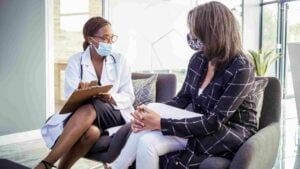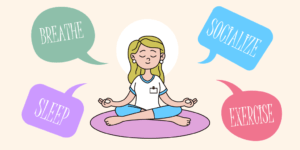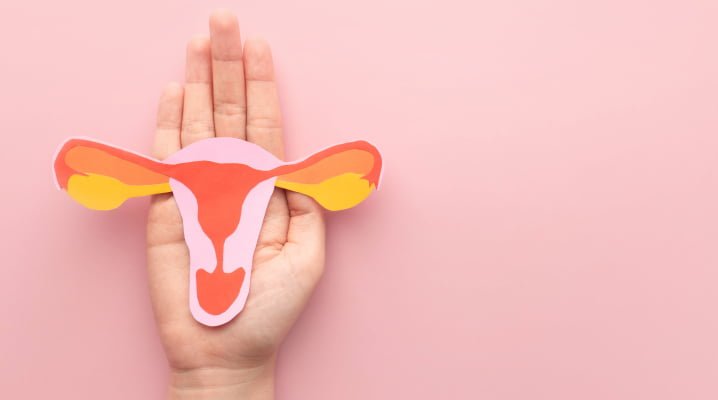Welcome to a crucial conversation about a topic that often remains in the shadows — urogenital atrophy. While it may not be a common topic of everyday discussion, its impact on the quality of life, especially in the realm of intimacy, is significant. Urogenital atrophy, a condition most prevalent in postmenopausal women but affecting individuals of various ages and genders, can lead to discomfort, pain, and a decline in sexual satisfaction. In this comprehensive guide, we’ll explore the various aspects of urogenital atrophy and delve into effective urogenital atrophy treatment options that can help individuals reclaim a fulfilling and comfortable life.
Contents
Understanding Urogenital Atrophy
 Urogenital atrophy, a condition predominantly experienced by postmenopausal women but affecting individuals across various life stages and genders, involves the thinning, drying, and inflammation of the vaginal walls and surrounding tissues. This occurs due to a decline in estrogen levels, leading to a range of uncomfortable symptoms such as vaginal dryness, itching, burning sensations, and pain during sexual intercourse.
Urogenital atrophy, a condition predominantly experienced by postmenopausal women but affecting individuals across various life stages and genders, involves the thinning, drying, and inflammation of the vaginal walls and surrounding tissues. This occurs due to a decline in estrogen levels, leading to a range of uncomfortable symptoms such as vaginal dryness, itching, burning sensations, and pain during sexual intercourse.
Beyond the physical discomfort, urogenital atrophy can have a profound impact on an individual’s quality of life, extending into emotional and psychological realms. The condition often remains underdiagnosed and undertreated, creating a need for increased awareness and open dialogue surrounding urogenital health.
Recognizing the symptoms of urogenital atrophy is essential for timely intervention and the initiation of appropriate treatment. While it is most commonly associated with menopause, certain medical conditions, medications, and even lifestyle factors can contribute to its development. Understanding the intricacies of urogenital atrophy is the first step toward empowering individuals to seek help.
Different Urogenital Atrophy Treatment Options
Several treatment options are available for urogenital atrophy, aimed at alleviating symptoms and improving the overall quality of life. Here are some examples:
Hormone Therapy (HT)
Hormone therapy is a common and effective approach to addressing urogenital atrophy, particularly in postmenopausal women. Localized estrogen therapy, available in the form of creams, tablets, or vaginal rings, directly targets the vaginal tissues, promoting the restoration of elasticity and moisture.
By replenishing declining estrogen levels, these treatments reduce symptoms such as vaginal dryness, itching, and pain during intercourse. However, it’s essential to consult with a healthcare provider to determine the most suitable form of hormone therapy, as systemic estrogen therapy, delivered orally or through patches, may carry additional risks and side effects.
Non-hormonal moisturizers and Lubricants
Over-the-counter products like water-based or silicone-based lubricants and vaginal moisturizers provide accessible and immediate relief from symptoms of urogenital atrophy. Lubricants can be applied during sexual activity to reduce friction and discomfort, while moisturizers when used regularly, help maintain vaginal moisture and alleviate dryness.
These products are often the first line of defense for individuals seeking symptomatic relief without hormonal interventions. They come in various formulations, allowing individuals to choose the one that best suits their preferences and needs.
Prescription Medications
 Ospemifene, sold under the brand name Osphena, is a prescription medication that acts as a selective estrogen receptor modulator (SERM). Specifically designed for postmenopausal women, Ospemifene targets estrogen receptors in the vaginal tissues to alleviate pain during sexual intercourse.
Ospemifene, sold under the brand name Osphena, is a prescription medication that acts as a selective estrogen receptor modulator (SERM). Specifically designed for postmenopausal women, Ospemifene targets estrogen receptors in the vaginal tissues to alleviate pain during sexual intercourse.
As an oral medication, it provides a systemic effect without relying on localized application. However, like any prescription drug, it should be used under the guidance of a healthcare professional who can assess its appropriateness based on the individual’s medical history and overall health.
Topical Estrogen Treatments
Estradiol cream or gel is a topical estrogen treatment applied directly to the vaginal area. This approach provides localized relief by delivering estrogen directly to the affected tissues, stimulating the regeneration of vaginal cells and improving overall tissue health. The convenience of topical applications makes them a preferred choice for many individuals.
Especially those who may experience adverse effects from systemic hormone therapy. Like other estrogen-based treatments, the choice of topical applications should be discussed with a healthcare provider to ensure safety and efficacy for the individual’s unique circumstances.
Vaginal DHEA (Prasterone)
Vaginal dehydroepiandrosterone (DHEA), often marketed as Prasterone, is a treatment option that addresses urogenital atrophy by providing a precursor hormone that is converted into estrogen and testosterone in the vaginal tissues. Available in suppository form, it offers a localized therapeutic approach. Vaginal DHEA has shown promise in improving symptoms such as vaginal dryness and pain during intercourse.
Pelvic Floor Physical Therapy
Pelvic floor physical therapy is a non-invasive approach that focuses on strengthening the muscles in the pelvic region. Specifically tailored exercises help improve blood flow to the genital area, promoting overall vaginal health. This therapeutic modality is particularly beneficial for individuals experiencing discomfort or pain during intercourse, as it addresses the underlying muscular factors contributing to urogenital atrophy. Pelvic floor physical therapy is often recommended as part of a comprehensive treatment plan and may be combined with other therapeutic approaches for optimal results.
Regular Sexual Activity
 Engaging in regular sexual activity, whether alone or with a partner, can be an integral aspect of urogenital atrophy management. Regular sexual stimulation promotes blood flow to the genital area, which helps maintain the elasticity and health of the vaginal tissues. For individuals experiencing discomfort, the use of vaginal dilators under the guidance of a healthcare professional can be beneficial. This approach is not only therapeutic but also contributes to the psychological and emotional aspects of intimacy. Ultimately, fostering a positive and proactive attitude towards urogenital health.
Engaging in regular sexual activity, whether alone or with a partner, can be an integral aspect of urogenital atrophy management. Regular sexual stimulation promotes blood flow to the genital area, which helps maintain the elasticity and health of the vaginal tissues. For individuals experiencing discomfort, the use of vaginal dilators under the guidance of a healthcare professional can be beneficial. This approach is not only therapeutic but also contributes to the psychological and emotional aspects of intimacy. Ultimately, fostering a positive and proactive attitude towards urogenital health.
These diverse urogenital atrophy treatment options highlight the importance of a personalized and holistic approach. A healthcare provider can assess individual needs, considering factors such as overall health, preferences, and the severity of symptoms, to tailor a comprehensive treatment plan. This addresses both the physical and emotional aspects of urogenital health.
Lifestyle Changes For Urogenital Atrophy Treatment
Adopting certain lifestyle changes can play a significant role in managing urogenital atrophy symptoms and promoting overall urogenital health. Here are some lifestyle changes that individuals can consider as part of their treatment plan:
Hydration
Staying well-hydrated is crucial for maintaining the moisture levels in the body, including the vaginal tissues. Dehydration can exacerbate symptoms of dryness and discomfort associated with urogenital atrophy. Drinking an adequate amount of water each day supports overall health. Also, it contributes to the well-being of urogenital tissues.
Nutrition
A balanced and nutritious diet is essential for overall health, including urogenital health. Incorporating foods rich in omega-3 fatty acids, antioxidants, and vitamins can positively impact tissue health. Omega-3 fatty acids in fish, flaxseeds, and walnuts have anti-inflammatory properties, while antioxidants help combat oxidative stress.
Avoiding Irritants
Harsh soaps, scented hygiene products, and douches can contain chemicals that may irritate the delicate tissues of the urogenital region. It is advisable to use mild, fragrance-free soaps and to avoid the use of douches, as these can disrupt the natural balance of the vaginal flora. Opting for gentle and hypoallergenic personal care products can help prevent further irritation.
Regular Exercise
Engaging in regular physical activity has numerous health benefits, including improved circulation and overall well-being. Exercise contributes to maintaining a healthy weight and promoting cardiovascular health, which indirectly supports urogenital health. Pelvic floor exercises, in particular, can be beneficial for strengthening the muscles in the pelvic region, potentially alleviating symptoms associated with urogenital atrophy.
Wearing Breathable Fabrics
Choosing breathable, cotton underwear and avoiding tight-fitting clothing can contribute to better urogenital health. Breathable fabrics help minimize moisture buildup, reducing the risk of irritation and promoting a more comfortable environment for the genital area.
Smoking Cessation
Smoking has been linked to a range of health issues, including reduced blood flow and increased inflammation. Quitting smoking can have positive effects on overall vascular health. Potentially benefiting urogenital tissues by improving blood circulation.
Stress Management
 Chronic stress can impact overall health, including urogenital health. Incorporating stress management techniques such as mindfulness, meditation, yoga, or deep breathing exercises can help alleviate stress and its potential impact on urogenital atrophy symptoms.
Chronic stress can impact overall health, including urogenital health. Incorporating stress management techniques such as mindfulness, meditation, yoga, or deep breathing exercises can help alleviate stress and its potential impact on urogenital atrophy symptoms.
Individuals experiencing urogenital atrophy should consult with a healthcare professional to discuss these lifestyle changes in the context of their specific symptoms and medical history. A personalized approach, considering both physical and emotional well-being, is essential for effective urogenital atrophy management.
Conclusion
In conclusion, understanding and addressing urogenital atrophy is crucial for reclaiming a comfortable and fulfilling life. By shedding light on this often-overlooked topic, we’ve explored various urogenital atrophy treatment options, from hormone therapy and prescription medications to non-hormonal approaches and lifestyle changes. Remember, there’s no one-size-fits-all solution, so it’s essential to consult with healthcare professionals to find the most suitable treatment plan based on individual needs.
Whether it’s adopting healthier habits, exploring medical interventions, or embracing open communication, this comprehensive guide aims to empower individuals to navigate the landscape of urogenital atrophy with knowledge, resilience, and a proactive approach to overall well-being. If you are facing menopause-related issues, menopause treatment at HerMantra can help. Book your free trial online menopause treatment session now.


